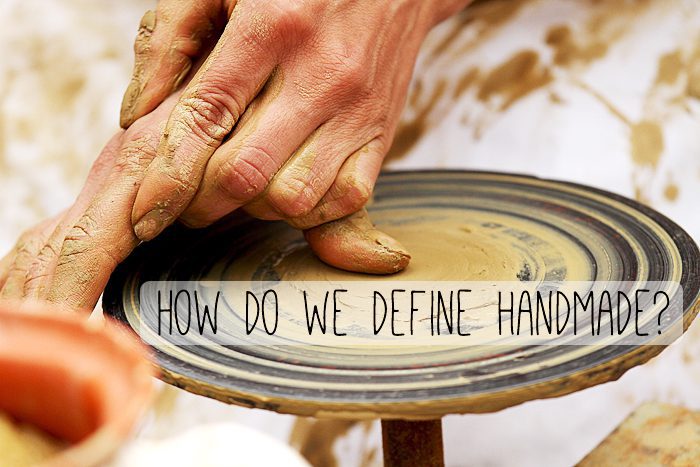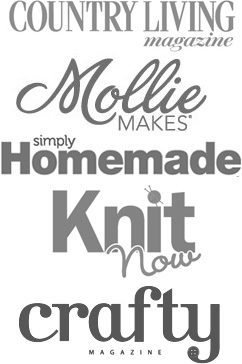What do we mean by handmade?
What is handmade?
We’re quick to blurt out the answer, but the truth is that defining the concept is getting a lot harder. It’s a bit like saying blue. There are a heck of a lot of shades of it!
When Etsy changed its definition of handmade last year, there was a lot of confusion. And backlash. The new policies meant that shops could hire others to help with high demand. (It’s not easy to churn out handmade goods all alone.) Before the change, Etsy sellers had to make their ‘handmade’ goodies themselves.
And since Etsy got so popular before they changed their policy, maybe that’s why so many of us think handmade means something made by one person, from start to finish.
Yet we can’t forget the community so many crafts thrive upon. I’m thrown back to childhood memories of quilting events at country fairs, where a dozen women stitched together on the same jumbo quilt. Those quilts are handmade, too.
A New Definition
Abby of While She Naps shared this video in her own post about defining handmade:
Should the handiwork of these people be devalued because of the factory setting? They’re screen-printing, stuffing, and stitching the same way anyone would do at home.
And the complications to defining handmade don’t end there, either. On Etsy photography, prints, laser cut items, and other goods have been defined as ‘handmade’. With the biggest handmade goods marketplace saying so, it’s easy to get used to the thought.
Is a sketch done on a tablet any less handmade than one on a canvas? Where does photography actually fit in? What about web design and typography? Does a craft kit make the handmade item less meaningful?
The truth is, handmade is what we make it.
To me, handmade gets its value from being a labour of love and design. I love buying handmade items from indie designers who make their own goods. That love continues when a brand grows and has to hire some help. If you ask me, that’s even better. It means more people are working to create something fun and wonderful.
To me, cameras and even mouse cursors are just tools, just like knitting needles and pottery knives. The tool doesn’t do the work for you. Someone uses that tool to create something. It still takes skill and time.
The capabilities of our tools are growing. Our definition of handmade has to grow, too.
How do you define handmade?
Whether you agree or disagree, I’d love to hear your thoughts!
xo,
![]()
*Pottery photo credit to ime






![August's Technique of the Month: Watercolours [REVIEW]](https://i0.wp.com/craftingfingers.co.uk/wp-content/uploads/2018/07/Cass-Art-watercolours-for-beginners-review-8.jpg?resize=200%2C200)







Maybe we should step away from using hand-made, and try using indie-made instead? When I machine knit something, it still takes skill – simply different skills from hand knitting. Perhaps like a potters wheel vs uh, no potters wheel? (Note my ignorance on pottery..!)
Of course there will be a grey area when employees are involved, but if there is no LARGE scale production lines, I think that would still count as Indie, to a certain extent.
I like indie-made!
My mother bought a knitting machine a couple years ago. Before that I had a very unrealistic idea of what they could do. It’s still very much a crafting tool in my opinion – you have to move the stitches by hand to do anything but stockinette! Very fiddly!
Indie is still a confusing term in some ways, though. For example I love the (now very well known) Katie Daisy. http://www.katiedaisy.com/ She’s just published a few of her designs with Hallmark. It’s a grey area but I still consider her ‘indie’!
When I buy handmade I’m looking more for the element of sustainable manufacture (sustainable materials, practices, wages and contribution to the wider world) than worrying too much about how much machinery is used.
So while I can see how you could use handmade in a factory setting I worry about how much of the industrial work ethic had leaked into that particular hand making whereas I was perfectly happy to be a piece worker for a one-woman business while I was a student because I maintained my own sense of being a maker rather than a very complicated machine.
Thanks for sharing your thoughts Katy, you hit the nail on the head here! Factory lines mean ‘handmade’ doesn’t always mean that the values we’d expect are there. In those cases I think ‘hand-assembled’ might be a good way of putting it.
I think Laura Clempson’s Clara & Macy biz and Lou Brown Designs are two great examples of small handmade businesses that get extra hands to help when needed.
I think the word itself lost meaning before Etsy implemented the new rules. I also think that each of us with different cultures and backgrounds find certain things “handmade” and other people don’t.
Personally I don’t think that certain things Etsy defined “handmade” before the new rules are actually handmade.
Even if on Etsy photography, prints and laser cut items have been defined as ‘handmade’, they’re asking for seller with these items to apply with manufacturers.
Hiya, loved this piece Anna, very interesting! It is a good question as most of the products I sell I would class as ‘handmade’ – although some of them are produced on a larger scale. For instance Kate a Hamilton-Hunter jewellery is now so popular she has to have a team of people making the jewellery as she has to be out there marketing and selling her brand. Doesn’t mean she doesn’t miss making the jewellery I would think, just a natural line from being successful! Also I sell Kutuu trinket dishes and keyrings, they were designed using traditional metal work methods but are produced by a British manufacturer now it’s successful – truth is for the maker, Hannah Soloman, I don’t think her product would be affordable to the general public if it was still low-scale handmade and not so many people could enjoy it!
So many different thoughts on this one – you’ve got me thinking! Claire x (www.two-ducks.co.uk)
[…] frame or not at all if you decide to look for another frame that you like. Twenty Fingers offers an authentic handmade product called floating frames, which omits the back cover in conventional frames. Still, you can also […]